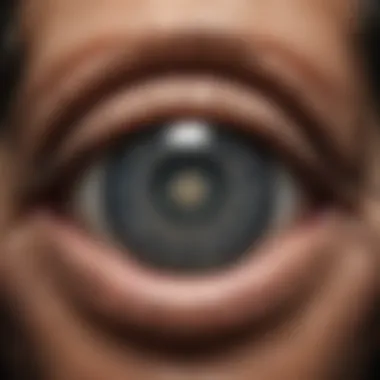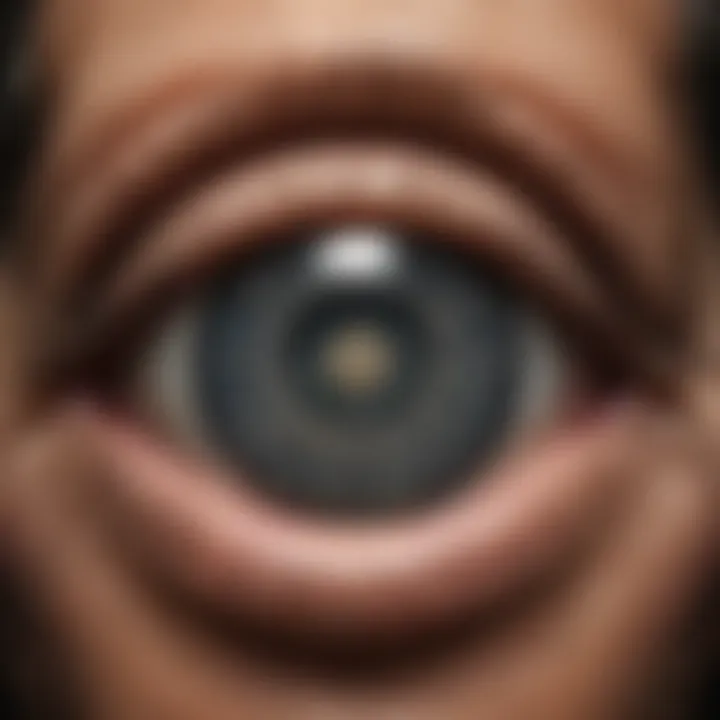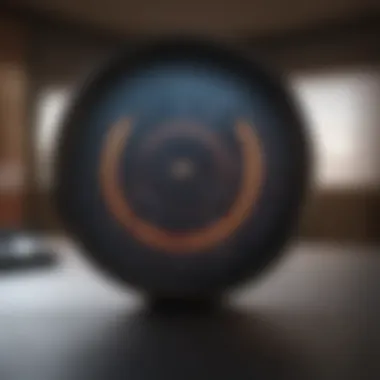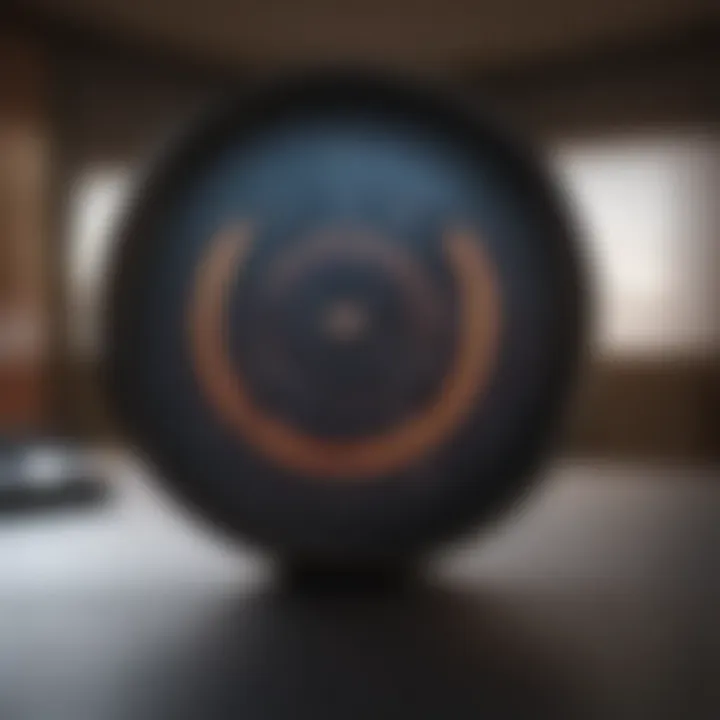Understanding Visual Acuity Test Charts and Their Relevance


Intro
Visual acuity test charts serve as a crucial tool in measuring the clarity or sharpness of vision. They have a rich history and have evolved over time to meet the needs of clinical settings. Understanding these charts allows for better assessment of patients' visual capabilities and ensures an accurate interpretation of results.
A visual acuity test typically involves a patient reading letters or symbols on a chart. This process helps in determining not just the degree of vision impairment but also assists in diagnosing underlying conditions. Various types of charts exist, including the Snellen chart and the LogMAR chart, each serving distinct purposes and offering unique advantages in visual assessments.
As technology advances, the methodology of conducting these tests is also changing, leading to improved accuracy and efficiency. The significance of a thorough understanding of visual acuity and its implications on broader health contexts cannot be overstated. A detailed examination of these elements will be explored in this article.
Preamble to Visual Acuity Tests
Visual acuity tests play a fundamental role in the assessment of an individual's vision quality. These tests gauge how well a person can see, which is integral to overall health and daily functioning. Understanding the intricacies of visual acuity testing is paramount, both for professionals in the field and for individuals seeking insight into their visual health.
Defining Visual Acuity
Visual acuity is a measurement of the eye's ability to discern shapes and details at a given distance. It is commonly evaluated using standardized charts featuring letters and symbols. These charts are designed to challenge the eye's capability, providing a clear metric for vision performance. The measurement is expressed in optotypes, commonly represented as a fraction, such as 20/20, indicating what an individual can see compared to what a person with normal vision can see from the same distance.
The term itself encompasses more than just clarity of vision. It includes factors such as contrast sensitivity and depth perception, which are essential for navigating the environment. Discerning these details allows healthcare providers to categorize vision into normal and subnormal ranges, impacting diagnosis and treatment.
Significance of Visual Acuity Testing
Visual acuity testing is not simply a routine practice; it underpins various aspects of medical intervention and patient care. First and foremost, it aids in the early detection of ocular conditions like glaucoma, cataracts, or retinal diseases.
Regular assessments can lead to timely interventions, potentially preserving vision and improving life quality.
Furthermore, the implications of visual acuity extend beyond the individual. In educational settings, for instance, a child's vision can have a profound impact on learning capabilities. Poor vision might hinder academic performance, leading to struggles that could have lasting consequences. Similarly, in occupational environments, visual acuity is critical for ensuring safety and efficiency, particularly in fields that rely heavily on visual tasks, such as surgery or piloting.
"Regular visual acuity testing provides not just a measure of sight but also an early warning system for more serious health issues."
In summary, comprehending visual acuity testing encompasses understanding its definition and significance. It sets the stage for exploring historical developments, methodologies, and advancements in technology that are shaping the future of visual assessment.
Historical Background
The historical background of visual acuity test charts offers an essential context for understanding their development and current applications. Over time, advancements in scientific knowledge and technology have significantly shaped the field of vision assessment. By examining the evolution of testing methods, one can appreciate how far we have come and the foundation it sets for future innovations in visual acuity testing. Understanding the historical context also allows professionals to recognize the importance of reliability and accuracy in visual testing, which are paramount for effective diagnosis and treatment of vision problems.
Early Methods of Vision Assessment
From ancient civilizations to the early modern era, the assessment of vision was rudimentary at best. Ancient Egyptians and Greeks attempted simple methods, such as observing if individuals could identify objects at various distances. This method lacked rigor and was subjective. However, names like Hippocrates and Aristotle laid the groundwork for future explorations by noting physical eye conditions.
The first significant progress was during the Renaissance period, which saw the birth of more structured approaches to vision testing. Instruments such as the pentomic lens were invented, allowing for greater precision in understanding how lenses could affect sight. Philoponus, a Greek philosopher, introduced the idea of measuring sight with letters and symbols, setting a precedent for chart-based assessments.
Evolution of Visual Acuity Charts
The evolution of visual acuity charts represents a transition from arbitrary measurement to standardized testing forms. In the early 19th century, the Snellen chart introduced by Hermann Snellen marked a pivotal moment. This chart utilized letters of varying sizes, which provided a basis for standardized visual acuity testing. The simplicity of the Snellen chart made it widely accepted in clinical settings.
As research progressed, modifications emerged. The LogMAR chart, developed later, offered improved precision and reduced variability between test results. The use of logarithmic values allowed for a more granular assessment of visual acuity.
Another innovation was the ETDRS chart, used primarily in research and clinical trials, which incorporated various letter combinations. This type of chart has become important in tracking the effectiveness of treatments for eye disorders.
As technology advanced, the introduction of digital charts and mobile applications further revolutionized the field. These modern tools are now capable of providing instant results and easily record data for future reference, thereby enhancing the overall testing experience.
Overall, the historical background not only highlights the progress in methods and tools but also marks significant progress in our understanding of vision. These insights pave the way for further developments in this critical field.
Types of Visual Acuity Charts
Understanding the various types of visual acuity test charts is crucial for assessing eye health and determining the need for corrective measures. Each type of chart offers unique benefits and considerations. A proper selection of the chart influences the accuracy of the vision assessment and helps eye care professionals in diagnostic processes. Here, we explore four distinct charts: Snellen, LogMAR, ETDRS, and other specialized charts.
Snellen Chart
The Snellen chart is perhaps the most recognized visual acuity test chart. Developed in the 1860s by Herman Snellen, it is designed with letters of varying sizes arranged in rows. The largest letters are at the top, progressively declining in size as one moves downward.
This chart measures visual acuity based on the capability of the viewer to identify letters from a specified distance, usually 20 feet in the United States. The common notation used is the fraction, like 20/20. This indicates what a person with normal vision can see at 20 feet.
Benefits of the Snellen chart include:


- Ease of use and widespread familiarity.
- Its simplicity makes it accessible.
- Provides a straightforward assessment of vision.
However, its limitations also exist. For instance, it does not account for higher acuity levels or uneven spacing of letters, which may affect the results.
LogMAR Chart
The LogMAR chart stands for "logarithm of the Minimum Angle of Resolution". It offers a more precise measurement of visual acuity compared to the Snellen chart. Each row on the LogMAR chart consists of letters that decrease in size, with each letter contributing equally to the overall score.
One significant advantage of the LogMAR chart is its standardization in design and measurement method. It allows for a clearer comparison of visual acuity across different studies and contexts.
Key points about LogMAR are:
- Provides a more accurate evaluation of visual performance.
- Reduces the variability that can arise due to letter difficulty or spacing differences.
- Useful for both clinical and research purposes.
ETDRS Chart
The ETDRS chart, short for Early Treatment Diabetic Retinopathy Study, was designed for clinical trials focusing on diabetic retinopathy. This chart also follows a logarithmic pattern similar to the LogMAR chart, ensuring consistent letter sizing.
The primary focus of the ETDRS chart is to assess the best-corrected visual acuity in individuals. It improves upon the traditional methods by minimizing test-retest variability.
Pros of using the ETDRS chart include:
- It is particularly useful in clinical settings for studying eye diseases.
- Has been standardized for better reliability in results.
- Allows for a thorough assessment of visual function in populations with diabetes.
Other Specialized Charts
Besides the well-known Snellen, LogMAR, and ETDRS charts, various specialized charts address specific needs. For example, the Lea Symbols chart caters to children and individuals who may not recognize letters.
Other examples include:
- Tumbling E chart: Often used for non-literate patients, it has a simple design that enables subjects to point in the direction of the "E."
- Freiburg Visual Acuity Test: Utilizes different shapes and arrangements tailored for diverse populations.
These charts serve specific assessments that typical charts may not adequately cover. They enhance inclusivity in vision testing.
Methodology of Conducting Visual Acuity Tests
The methodology of conducting visual acuity tests is crucial for ensuring accurate and reliable vision assessment. This section provides a structured approach to testing that aims to minimize variability and bias in results while focusing on the overall patient experience. It will discuss three key elements: the setup of the testing environment, the actual testing procedures, and how results are recorded and analyzed.
Setting Up the Testing Environment
A well-organized testing environment is essential for the integrity of visual acuity assessments. Lighting conditions, distance from the test chart, and the position of the patient all play critical roles in measurement accuracy.
- Lighting Conditions: It is vital to ensure consistent and adequate lighting. The room should be illuminated with uniform brightness to avoid shadows or glare on the chart. Adjusting light sources regularly helps maintain optimal conditions.
- Distance: Standard testing distances must be maintained. For example, the Snellen chart is generally placed at 20 feet. Care should be taken to mark this distance clearly to esure patient positioning is accurate.
- Patient Positioning: Patients should sit comfortably, with their heads straight and eyes level with the testing chart. Using head rests or chin supports can help achieve this.
Setting up correctly prepares both the examinee and examiner to focus on the task at hand, leading to more reliable outcomes.
Testing Procedures
The testing procedures involve systematic steps to evaluate a patient's visual acuity. Following a structured protocol ensures that the results reflect the patient's vision accurately and comprehensively.
- Initial Instructions: Patients should be informed about the process. Clear instructions reduce anxiety and promote cooperation during the test.
- Chart Selection: Depending on the context, practitioners might choose specific charts like the Snellen or LogMAR chart. Each has criteria for use based on the patient's needs.
- Test Execution: Patients cover one eye and read from the chart, moving from larger to smaller letters. The examiner should observe the patient's comfort and understanding throughout the process.
- Repetition: Each eye should be tested separately and then both together to furnish a complete assessment.
This structured approach allows practitioners to gather meaningful data on a patient's visual capability.
Recording Results
Accurate recording of results is imperative for monitoring patient progress and making informed clinical decisions. Key considerations include:
- Standardization of Results: Results should be documented in standard format, such as indicating the lowest line read successfully. Utilizing software tools for recording can minimize errors.
- Descriptive Notes: Include any additional information, such as whether the patient needed assistance or had any visual disturbances. This adds context to the raw numerical data.
- Follow-Up Measurements: Regularly updating records ensures that any changes in vision over time are captured, facilitating timely interventions where necessary.
By meticulously recording results, healthcare professionals can track visual acuity trends more effectively, leading to better patient care decisions.
Proper methodology in visual acuity testing ensures reliable results. Accurate results lead to better patient outcomes.
Interpreting Visual Acuity Results


Interpreting visual acuity results forms a crucial aspect of understanding how vision is assessed. The outcomes of these tests influence clinical decisions regarding eye care and patient management. A clear understanding of these results helps healthcare providers tailor treatment options based on the specific needs of the patient. The interpretation is not merely about determining a value; it encapsulates the entire vision health journey for the individual.
Understanding Measurement Units
Visual acuity is typically expressed in fractional forms, most commonly as a Snellen ratio, such as 20/20. The first number indicates the distance in feet at which a person can see a certain line on the chart. The second number refers to the distance at which a person with normal vision can see that same line. For instance, a visual acuity of 20/40 means that a person can see at 20 feet what a person with normal vision can see at 40 feet.
Another common unit is LogMAR, which is used to quantify visual acuity in an additive manner. The LogMAR scale provides a more sensitive measure of vision quality, allowing for a finer distinction between different levels of acuity. This is particularly useful in clinical research or cases where subtle differences in vision matter most.
"Clear communication of visual acuity values is essential for maintaining precise patient care."
Normal vs. Abnormal Visual Acuity
Normal visual acuity typically ranges from 20/20 to 20/25 for most individuals. However, any score worse than 20/40 may indicate potential vision problems. It is essential to recognize differences between normal and abnormal results, as they can signify various underlying conditions. For example, a 20/50 result could suggest moderate vision impairment, while 20/200 is classified as severe visual impairment, often warranting further eye examination.
Patients may experience fluctuations in visual acuity based on several factors including fatigue, lighting conditions, or health changes. This variability necessitates regular assessments to track trends over time and determine if intervention is required. Understanding these variabilities also helps in setting realistic expectations for patients and informing them about treatment options.
Common Visual Acuity Disorders
Several disorders affect visual acuity, impacting an individual’s day-to-day functioning. Common issues include:
- Myopia (Nearsightedness): Individuals see near objects clearly while distant objects appear blurred.
- Hyperopia (Farsightedness): This disorder allows clear vision for distance but causes blurriness when looking at close objects.
- Astigmatism: The eye is unable to focus light evenly on the retina due to an irregular shape, leading to distorted vision.
- Presbyopia: Typically affecting those over 40, this condition results in difficulty focusing on close objects.
Recognizing these disorders through visual acuity tests is the first step towards effective management. It also highlights the importance of timely vision screening and intervention, especially in children.
Factors Affecting Visual Acuity Testing
Visual acuity testing is a nuanced process that encompasses various factors. Understanding these factors is essential for obtaining accurate outcomes. Each element plays a critical role in ensuring that the results of visual acuity tests reflect the true vision capabilities of an individual. First, we will explore lighting conditions, then move to patient factors, and finally examine chart design and quality. All of these elements must be carefully considered in any clinical scenario.
Lighting Conditions
Lighting conditions during visual acuity tests have a significant influence on test results. Inadequate or excessive lighting can distort perceptions during the testing process. It is crucial to establish appropriate illumination for test charts. For instance, natural daylight can be ideal, but controlled artificial lighting may also be effective. The brightness and profile of the light source should be uniform; otherwise, shadows can create unwanted variables.
Furthermore, glare can impede readability on test charts. To mitigate this, using diffused lighting can help present a clearer image. It is advisable to perform assessments in the same or similar lighting conditions for consistency across multiple tests.
Patient Factors
Patient-specific elements contribute greatly to the variations in visual acuity test outcomes. Factors such as age, pre-existing conditions, and even psychological state can affect performance. Older adults may struggle with contrast sensitivity, which can skew results. Moreover, if a patient is anxious or fatigued, their ability to focus might diminish, leading to inaccurate readings.
A comprehensive approach to visual acuity testing should include a detailed medical history. It helps to identify any issues that might influence vision. Additionally, personal comfort is essential. Providing a relaxed environment can yield more reliable results.
"Patient comfort and state of mind can significantly affect test performance."
Chart Design and Quality
The design and quality of visual acuity charts are paramount to obtaining valid results. Various chart types, such as the Snellen and LogMAR charts, boast distinct features that cater to different testing environments. High-quality materials and clear print are essential to prevent misinterpretation of letters or symbols. If a chart is poorly designed or printed, the capacity to measure visual acuity accurately gets compromised.
Moreover, the arrangement and size of letters can influence testing accuracy. Charts must be calibrated and standardized to maintain reliability. Continuous updating of the charts used in practice ensures clinicians have access to the best standards available. Regular reviews on the effectiveness and design of these charts are also fundamental for ongoing quality improvement.
Technology in Visual Acuity Testing
The field of visual acuity testing has seen significant advancements due to technology. Modern tools and methods have enhanced the accuracy and accessibility of vision evaluations. Understanding these technological developments is crucial for both practitioners and patients. It allows them to navigate the increasingly complex landscape of vision testing and make informed decisions.
Digital innovations have transformed traditional practices. These new technologies provide more reliable results and streamline testing processes. Practitioners can conduct tests more efficiently, freeing up time for other important clinical activities.
Digital Visual Acuity Testing
Digital visual acuity testing represents a significant leap forward from conventional charts. Devices like digital screens can adjust brightness and contrast. This adaptability helps enhance the clarity of letters or symbols used in testing. Patients can experience a more standardized testing environment. This uniformity reduces variables that might affect the outcome.
Digital systems often include automated features that assist in recording results. Data can be stored and analyzed more easily than with paper charts. This can provide insights into trends or changes over time in a patient’s vision.
Moreover, digital tests can be programmed to present a variety of stimuli. This versatility allows assessments tailored to specific patient needs. Comprehensive evaluations become more achievable in a shorter time frame.
Mobile Apps for Vision Testing
The proliferation of smartphones has given rise to mobile applications designed for vision testing. These apps extend the convenience of visual acuity testing beyond clinical settings.


Patients can now test their vision from their own homes. Mobile apps often mirror the methodologies used in traditional tests. They can include digital representations of Snellen or LogMAR charts. Some applications even offer vision tracking features, allowing users to monitor changes over time.
However, the reliability of mobile apps depends on several factors:
- Screen quality: The resolution and brightness of a user’s device can impact test outcomes.
- User instructions: Clear guidance is essential to ensure the tests are administered correctly.
- Environmental factors: Testing in different lighting situations can lead to inconsistent results.
Despite these concerns, mobile vision testing apps provide valuable tools, especially for those who might have difficulty accessing traditional eye care services. They democratize vision testing by making it widely available, though they should complement rather than replace professional assessments.
Innovations in visual acuity testing should be seen as tools that enhance traditional methods, not as replacements. The best outcomes come from an integrated approach.
Visual Acuity in Broader Health Context
Visual acuity plays a crucial role in overall health management far beyond simple vision tests. It serves as a significant indicator of various underlying health conditions. By assessing visual acuity effectively, healthcare professionals can gauge not only the status of eye health but also the all-encompassing well-being of a person. Monitoring visual acuity can lead to early detection of diseases that may not be immediately evident, such as diabetes or hypertension.
Impact on Quality of Life
The relationship between visual acuity and quality of life is profound. Individuals with compromised vision often face challenges that permeate various aspects of life, including personal, social, and professional fields. Reduced visual acuity can limit one’s ability to perform daily activities, such as reading, driving, or recognizing faces. These limitations may result in heightened feelings of isolation or dependency on others for assistance.
Moreover, studies indicate that there is a strong correlation between visual health and mental well-being. Individuals with poor visual acuity are at an increased risk of experiencing conditions such as depression or anxiety. Enhancing visual acuity through effective testing and treatments not only can improve an individual's confidence but also foster greater independence and enhance overall life satisfaction.
Visual Acuity and Public Health
Understanding visual acuity also holds substantial implications for public health. The prevalence of untreated visual disorders not only affects individuals but also places a significant strain on healthcare systems. As visual impairment can lead to complications in other health areas, addressing it is vital for reducing future healthcare costs.
Preventative measures, such as regular visual acuity screenings, can lead to early interventions that may prevent serious health complications. Regular testing becomes especially critical in populations at greater risk of developing eye diseases, such as the elderly or those with diabetes.
In community health programs, increasing awareness about the importance of visual acuity could lead to higher participation in routine eye exams. This proactive approach can ultimately improve the quality of life on a larger scale and contribute to the overall health literacy within communities.
"Investing in eye health will lead to a healthier, more productive community."
In summary, visual acuity is not just about seeing better; it is intrinsically tied to quality of life and larger societal health outcomes. Engaging in comprehensive visual acuity testing and integrating findings into broader health strategies will enhance individual and public well-being.
Future Directions in Visual Acuity Testing
As our understanding of visual health continues to advance, the future directions in visual acuity testing are more critical than ever. The methods used to assess visual acuity are evolving, driven by technological innovations and our increasing understanding of how vision functions. Incorporating new testing methodologies and artificial intelligence can enhance the accuracy and accessibility of visual acuity assessment. This allows for better diagnosis and treatment options.
Innovations in Testing Methodologies
Testing methodologies in visual acuity have been under constant scrutiny for improvement. Emerging innovations focus on enhancing precision and user experience. Remote testing is one significant innovation that allows patients to take vision tests in their homes. This approach not only improves accessibility but also has the potential to gather more accurate data about patients’ vision.
New methodologies also prioritize adaptability. For instance, test charts can now be customized for individual needs, accommodating diverse populations. These innovations include the use of color contrast testing and adaptive visual targets, which adapt based on the patient's responses.
The shift towards incorporating mobile technology is notable. With dedicated mobile apps, users can self-administer visual acuity tests, making it easier for them to monitor their vision regularly. Thus, these innovations in testing methodologies present an opportunity for early detection of visual issues.
Integration of Artificial Intelligence
Integrating artificial intelligence in visual acuity testing holds vast potential. AI can analyze data from visual tests more efficiently than traditional methods. For example, deep learning algorithms can interpret the results of visual acuity tests with precision, identifying patterns that may indicate underlying issues.
AI tools can also assist in creating personalized testing approaches. By learning from previous results, AI can suggest optimal testing conditions, such as lighting and distance, tailored to each patient. It can guide practitioners in diagnosing and predicting conditions more accurately than ever before.
Moreover, AI-driven applications can facilitate evidence-based recommendations for treatment strategies. This kind of integration may revolutionize how we approach vision care, improving patient outcomes significantly.
In summary, as we progress into the future, visual acuity testing will likely become more sophisticated, patient-centered, and integrated with technology. The innovations in testing methodologies and the incorporation of artificial intelligence are pivotal for refining the ways we assess and improve vision, ultimately benefiting both patients and healthcare professionals.
Culmination
The conclusion serves a critical role in the overall framework of this article. It encapsulates the significance of visual acuity test charts and their vital contributions to the field of vision testing. As a summary, it highlights the essential insights shared throughout the article, reinforcing the understanding of visual acuity assessment.
Summary of Insights
Visual acuity test charts act as a linchpin in the evaluation of an individual’s visual performance. The various types of charts, such as the Snellen and LogMAR charts, each possess unique methodologies tailored to meet specific diagnostic needs. This discussion elucidates how these charts have evolved over time, adapting to advances in optical science and technology. A key takeaway has been the various factors that affect the accuracy of visual acuity tests. Conditions such as lighting, patient cooperation, and chart design all contribute to the reliability of results. Thus, understanding these elements is crucial for practitioners.
Furthermore, visual acuity is not merely a clinical figure; it influences quality of life and public health at large. The impact on individual well-being is profound, and a clear comprehension of this topic enables professionals to advocate for better health outcomes. The integration of technology into visual testing, including digital platforms and mobile applications, presents new avenues for accessibility and efficiency.
Call to Action for Further Research
It is imperative to encourage further research in the realm of visual acuity testing. With continual innovations and the integration of artificial intelligence, the potential for enhanced testing methodologies is vast. Researchers and practitioners are urged to explore how emerging technologies can refine testing accuracy and streamline procedures.
Moreover, collaborative studies can promote a deeper understanding of how various factors influence visual acuity readings. Future investigations should also consider the societal implications of vision impairment and the accessibility of testing resources across diverse populations.
In summary, the evolving landscape of visual acuity testing holds significant promise. By prioritizing research and application, we can anticipate improvements that not only build on established practices but also pave the way for more comprehensive models of eye health assessment.















